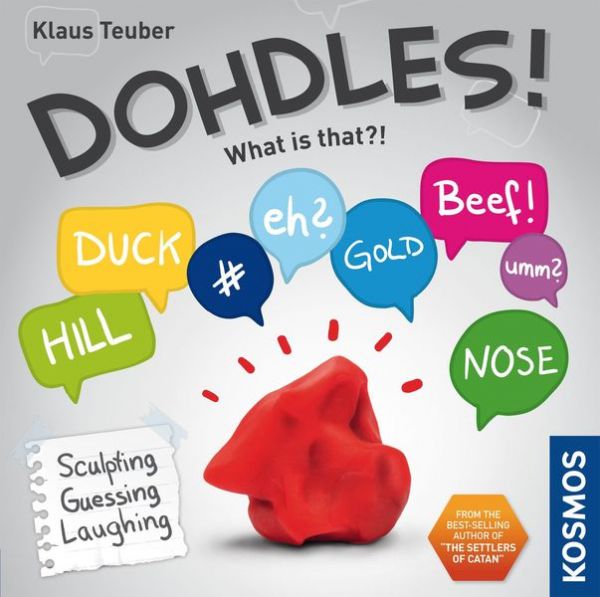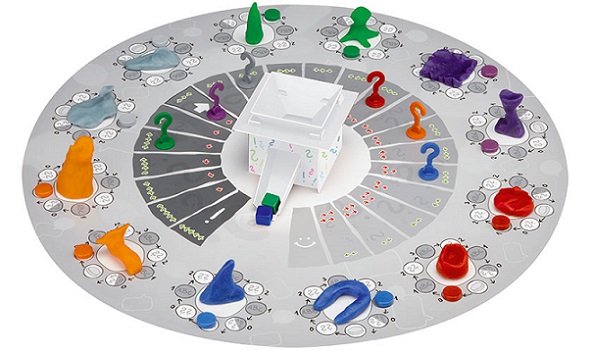Clay Sculpting Meets 20 Questions and Hangman in Dohdles

Let your inner sculptor shine! Create various figures, animals, and shapes out of clay and hope others will figure out what they are, only not too fast or you won’t get any points.
Dohdles! has players trying to strike a fine balance with their creations between making things too easy to guess and too hard. You must use your wits both in guessing others' dohdles and while creating your own.
Gameplay
The board is placed in the center of the table with a small box in the center. There is an opening at the top of the box and a chute leading out of it. Players place their player tokens on the score track. Each space on the track shows how many spaces forward your move your token for a correct guess and how many spaces backward you move for an incorrect guess when your token occupies that space. Along the outside edge of the board are the dohdle spaces.
At the start of the game, each player takes a suggestion board — these have suggestions for questions you can ask during the guessing phase of the game and suggestions for dohdles you can create. After you've played the game a few times, you can come up with your own creations without the suggestion board.
There are two phases in the game, the sculpting phase and the guessing phase. During the sculpting phase, each player uses their own colored sculpting dough to create two or three sculptures (or as the game calls them: dohdles). These can be a wide range of things such as animals, a famous landmark, or a household appliance. The trick is to make each sculpture so that it will not be too easily guessed but also so that it will not be too difficult to guess, either. You place each sculpture on a dohdle space. Around each dohdle space is also a clue track and a clue token is placed on the beginning space of each one.
Once all the sculptures are finished and on the board, the guessing phase begins. Players take turns asking for clues. On your turn, you choose any one clue token and move it forward one space on its track. You then ask the maker of the relevant dohdle for a clue. If the clue token is on a question mark space, you may ask two questions about the dohdle (though you may not ask about the spelling of the word), and the sculptor may answer with 'yes', 'maybe', 'no', or 'cannot be answered clearly'. If the clue token is on a gray space, you may ask for one of the first five letters of the solution word, which is written on a small sheet and placed near the sculpture. The final space on each clue track is a dual (white and gray) space, which allows you to choose which type of clue you want.
At any time, after a dohdle has had at least one clue given for it, one or more players can shout 'Dohdles!' and toss their guessing cubes into the box. If multiple players do so at the same time, you take turns announcing your guesses in the order your cubes came out of the chute. You move your player token forward if you guessed correctly or backward if you guessed incorrectly. If you guess correctly, the creator of the dohdle may also move their token forward zero to three spaces on the score board, depending on which space the clue token occupies on the track. If people guess too early, the creator doesn't more forward at all — the same applies if it takes too long for anyone to figure it out. The game ends once a player token reaches the final space on the score tracker or once no more dohdles are available to solve on the current turn. The player who is farthest along the score track wins.

Review
Dohdles! offers a lot of flexibility and creativity. You are not bound by the suggestion board and are free to come up with your own ideas when creating your sculptures. Striking that perfect balance between abstract and not overly detailed can be challenging, and has you putting a lot of thought into each sculpture. The freedom in your creations also leads to some tough rounds as guesser.
The dough used for creating the sculptures is easy to work with. It’s not hard to tear off pieces or to manipulate. It’s also not too sticky or liable to make a mess while you work with it, though it does leave enough residue on your fingers that you can feel it after you work with it. But since the sculpting is done all at one time, you won’t be repeatedly getting your hands dirty throughout the game.
How the clues are given and the different types of clues, give you plenty of information without making things too easy. The different types of clues also means you have some interesting choices when deciding which dohdles to get clues for. You also need to pay attention to every clue on every turn, so there is no down time at all.
The game looks really neat, with fun colors and solid components. The dexterity aspect, tossing your cubes into the box and down the chute, is a lot of fun and offers an objective way to determine guessing order when multiple people figure out a dohdle at the same time. But players who don't like speed or dexterity in their games might be turned off by it.
If you like party games with a creative twist, Dohdles! should be right up your alley. It combines the fun of sculpting clay from games like Cranium with the guessing mechanisms from 20 Questions and Hangman. There’s a lot of flexibility in it and creative freedom, and it’s nice to have all the sculptures on the table at one time so that you can study everything and always be thinking up guesses.
Pros: Lots of creative flexibility in what you sculpt, fun clue giving system, no down time, objective guessing order mechanism
Cons: Some players will not enjoy the dexterity aspect, sculpting dough leaves residue on hands
Disclosure: we received a complimentary review copy of this game.







